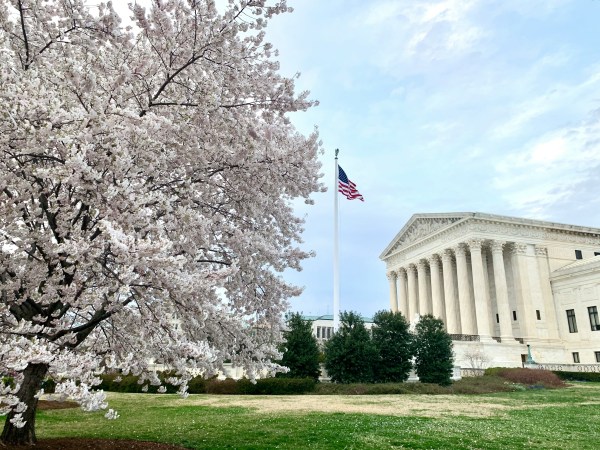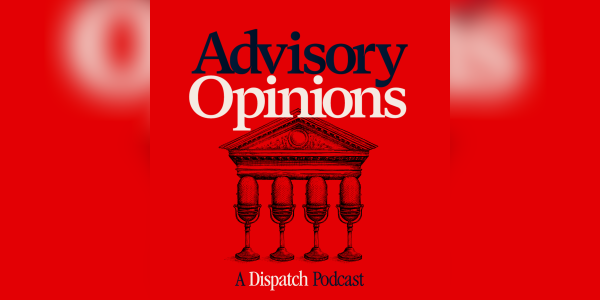Over the past few decades, textualism—which holds that textual analysis best reveals a legal provision’s meaning—has established itself as the interpretive theory in American courts. It has drawn its strength from formalism emphasized by champions such as the late Justice Antonin Scalia, combined with what Judge Neomi Rao has called textualism’s “political morality.” Scalia regularly pointed out that a law’s words are the “objectified” evidence of its meaning, and Judge Rao has elaborated that focusing on such objectified evidence “follows naturally from the moral commitments at the heart of our constitutional system of government.” Textualism has become so dominant that it’s sometimes hard to remember how debates over interpretation sounded before they were waged on textualist grounds. What did lawyers argue about before we disputed semantic meaning, context clues, and canons of interpretation?
Retired Supreme Court Justice Stephen Breyer has written a book to try to remind us. In Reading the Constitution: Why I Chose Pragmatism, Not Textualism, Justice Breyer notes that he may be the last anti-textualist standing. By revisiting the interpretive theories that roamed the earth before the textualist meteor hit and showing how they helped him reach his conclusions in various cases, Breyer’s preferred arguments against textualism take shape. Along the way, he attempts to advance an alternative interpretive mode which, as the book’s subtitle suggests, he calls “pragmatism.”
Unfortunately for him, those arguments end up sounding like little more than an expiring theory’s last gasp.
Pragmatism comprises a set of considerations beyond the text. It incorporates “purposivism,” long regarded as textualism’s chief rival, which Breyer considers the centerpiece of any alternative to textualism. Purposivism revolves around the idea that each law is enacted to solve a problem; curing some social ill is its “purpose.” Judges should therefore identify the problem Congress (or any legislature) sought to fix and apply the law in such a way that would give effect to Congress’ chosen remedy. The purposivist judge tends to view textualists as embracing willful blindness to the legislative will, forcing the legislature to idiot-proof its work product to an impossible degree if it ever wants to fix our nation’s problems.
Scalia dispensed with this critique nearly three decades ago: “To be a textualist in good standing, one need not be too dull to perceive the broader social purposes that a statute is designed, or could be designed, to serve; or too hidebound to realize that new times require new laws,” he wrote in 1995. “One need only hold the belief that judges have no authority to pursue those broader purposes or write those new laws.” In this view, purposivists who ask judges to use their common sense and let Congress fix the problem the way it was trying to beg the question: How precisely was Congress trying to fix the problem?
There is no simple answer because all legislation involves tradeoffs. How must we balance environmental protection against economic development? Public health against individual liberty? A congressional command to advance one interest does not mean it should always defeat the other in court.
Yet giving effect to a law’s purpose entices a judge to deal with tradeoffs in two ways. He can barrel ahead remedying one problem at the expense of all others, hyper-attuned to the purpose of a law he is asked to interpret, believing he is meant to help Congress fix that problem at any cost. Alternatively, a judge can feel empowered to make policy tradeoffs on his own, based on his own understanding of which competing goods are worth trading off—in other words, what the judge thinks would be good public policy. Either way, judges operating under such a theory end up circumventing the text of a law, which is the very command instructing them how to effect the tradeoff.
As his case studies illustrate, Breyer’s pragmatism led him to do both. His justifications for making independent policy judgments reveal a deep irony in the accusation, leveled against Scalia, that textualists lack the imagination needed to fix the problems Congress had identified. However, as the book progresses, it becomes clear that it’s actually pragmatism that suffers from a congenital lack of imagination.
When he revisits illustrative cases, Breyer emphasizes his reliance on reconstructing imaginary congressional logic to avoid interpreting texts’ commands. He considers “the main question” in statutory interpretation to be “the ‘why’ question”: Why would Congress prefer the outcome suggested by a textualist analysis over some other? When he “could find no good answer to the ‘why’ question,” he writes, he would dissent from the textualist interpretation. But the very fact that he could not conjure such answers reveals a blinkered view of politics and a lack of attention to a core feature of the American democratic system.
At its core, textualism is about compromise. It understands that in a democracy, it’s legislative majorities who ratify laws. It comprehends majorities arrive at an approved text only after an untold amount of horse-trading, coalition-building, and red-penning. Though its critics might paint it as a rigid or arcane legal philosophy, textualism is actually part of a comprehensive political and constitutional theory, one that holds that failing to give voted-upon words their due honor is tantamount to undermining the American people’s elected representatives by marring their compromise.
To make this more concrete, consider a case study that features prominently in Reading the Constitution. In the 2019 case Return Mail, Inc. v. United States Postal Service, the Supreme Court had to decide whether “a person,” as referenced in a statute allowing the Patent and Trademark Office to expedite post-grant patent reviews, included government agencies. The six-justice majority employed textualist reasoning and found that “person” did not include government agencies because (among a few other reasons) the United States Code defines the term as including “corporations, associations, firms, partnerships, societies, and joint stock companies, as well as individuals”—but not agencies.
Breyer wrote for the three dissenting justices, offering his “primarily purpose-oriented” interpretation. He reasoned that “Congress enacted the statute” at hand to “make the patent system more efficient.” He reasoned further that “this purpose was satisfied whether government parties or private parties used the statute’s administrative-based patent-validity challenge procedures.” The language of the statute suggested a clear answer to the question of who is “a person” under this law, but it would result in an only partially more efficient patent-challenge system.
Rather than accepting that this may have been the compromise Congress wanted, Breyer argued that the court should have circumvented the compromise by elevating “efficiency” at the expense of all other potential concerns. It did not make sense to him that Congress would go only some of the way toward advancing efficiency: “Why … would Congress have declined to give federal agencies the power to invoke those same administrative procedures? The dissenters could find no good answer to the ‘why’ question.”
Without getting bogged down in patent-law policy and administrative procedures, we can answer Breyer’s “why” question with a powerfully simple answer: Because democratic politics are messy. Compromise is messy. Getting that last vote to secure a majority may require some bartering: One representative may want funding for a new bridge in his district; another may support changes to the patent-challenge system while being concerned that government agencies are already too large and will hire more lawyers if the agency is allowed to invoke new administrative procedures. Their concerns may be idiosyncratic, but they need not strike Supreme Court justices as well-warranted to be democratically legitimate. Yet the pragmatic justices, led by Breyer, were quick to risk undoing any and all behind-the-scenes compromise by ignoring the best evidence of the compromise’s content—the text of a statute—in favor of analysis that simply cannot account for the vagaries of democratic lawmaking.
Though court critics often level the charge of “legislating from the bench” frivolously, in this case it hits the mark. It’s bad enough for judges to ask what “reason” there might be for a peculiarity in legal text. But at least this would confine the judiciary’s circumvention of legislative text to instances where it identifies undeniably absurd results. It’s far worse to inquire after “good” reasons, as if the Supreme Court were equipped to determine which kinds of compromises are acceptable, which result in the best policy outcomes (such as maximal efficiency), and which need to be circumvented by judicial “reinterpretation.”
By asking if there are “good reasons” for imperfect outcomes, Breyer’s method necessarily imports implicit understandings of good lawmaking and good governance, lumping in with the truly absurd anything the judges think is contrary to wise policy. Though it takes the form of legal interpretation, it is fundamentally an act of political theorizing by fiat. This feature of Breyerian pragmatism borrows heavily from the “Legal Process” school of interpretation articulated in the mid-20th century by Harvard Law School titans Henry Hart and Albert Sacks. Back then, Hart and Sacks emphasized that statutory interpretation must occur under the fiction that “the legislature was made up of reasonable persons pursuing reasonable purposes reasonably.”
The trouble, though, is that our legislature now constantly seems intent on exploding that assumption. Pointing that out is a joke, but a joke can be a serious thing. The serious criticism of Legal Process reasoning is that members of Congress do not always, or even often, legislate in a manner that Breyer or anyone outside of Congress would consider reasonable. That doesn’t make it illegitimate.
Lawmaking and sausage-making really do have much in common. The process is ugly and the result may be a touch unsettling. But trying to un-emulsify the sausage is a fool’s errand; likewise, trying to reconstruct a law’s components with unwarranted assumptions about their inherent reasonableness is not justifiable or even feasible.
Breyer insists, against this textualist critique, that his interpretations reflect what Congress obviously meant to convey. Yet that raises two questions: First, why didn’t Congress just say it? Examining Return Mail, Inc., again, the congressional bureaucracies in charge of precise legislative language know what the word “persons” means in the U.S. Code. It is not beyond Congress to say “persons and government agencies” in the statute disputed. Second, what’s the harm in ruling that Congress has not yet effected its desired policy outcome, and—since it is clear and uncontroversial to the point that pragmatists are prepared to assume it has already been ratified by implication—let Congress amend the law to mean what Breyer thinks it meant to say? It should not be hard to get a majority to make this one small amendment, since there’s no answer to “the ‘why’ question” to begin with. Right?
Wrong—of course, wrong. Congress ratified what it ratified because it compromised. And whatever language Congress would use to try to ratify the pragmatist’s twist on the law might well fail. It is not the compromise Congress had settled on; it may or may not command a majority. No wonder the textualist rejection of Breyer’s methodology has won the day. There is simply no justification for a Supreme Court justice going beyond a law’s text based on his own views of what is reasonable and what a reasonable legislature must have been trying to do.
Breyer’s book reads as one final appeal in the long-running litigation between his position and Scalia’s. Unfortunately, it raises no novel arguments, and it simply restates the anti-textualist position rather than mounting a rebuttal to textualism’s well-developed political and constitutional theory. If the anti-textualists cannot come up with a more persuasive rejoinder to textualists’ compromise-based theory, they should expect to continue losing in the court of public opinion.







Please note that we at The Dispatch hold ourselves, our work, and our commenters to a higher standard than other places on the internet. We welcome comments that foster genuine debate or discussion—including comments critical of us or our work—but responses that include ad hominem attacks on fellow Dispatch members or are intended to stoke fear and anger may be moderated.
With your membership, you only have the ability to comment on The Morning Dispatch articles. Consider upgrading to join the conversation everywhere.